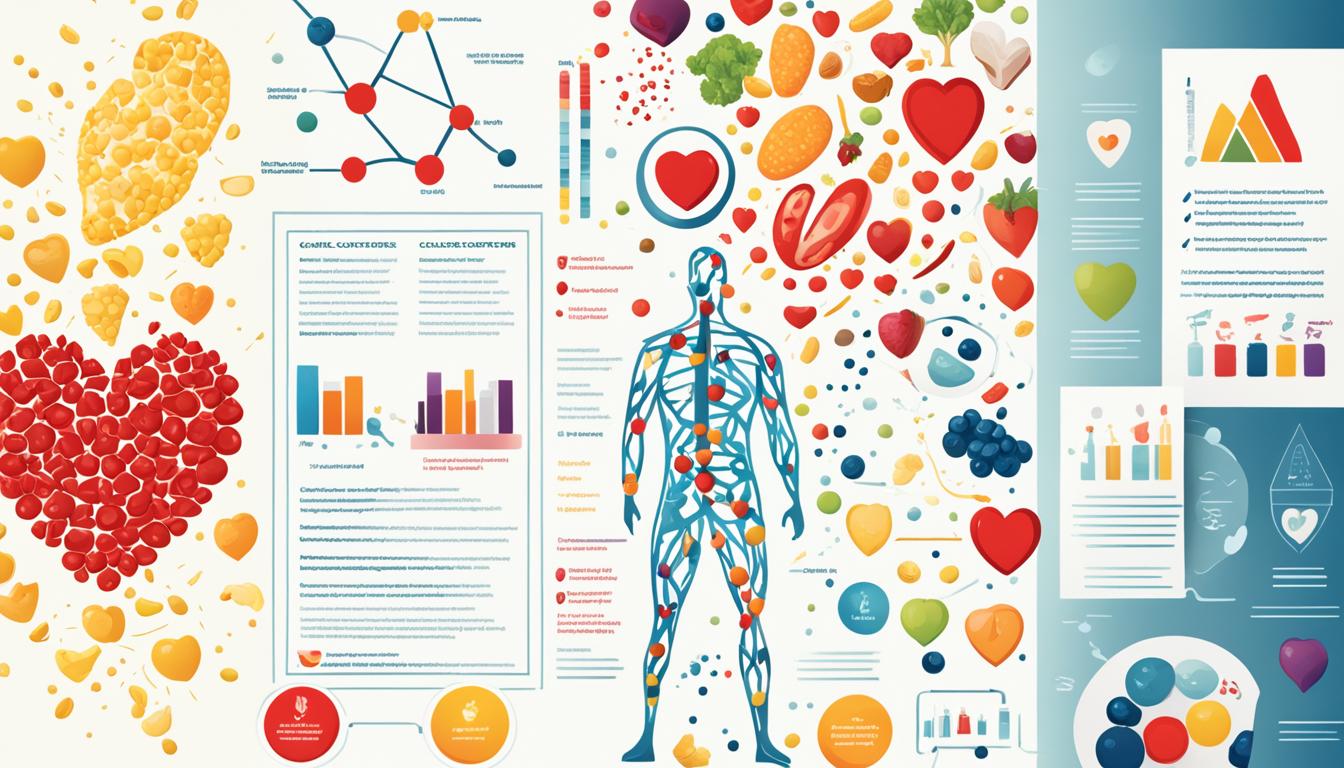Cholesterol is a topic that often sparks concern when it comes to our health. We’ve all heard that high cholesterol is bad for us, but do we really understand what cholesterol is and how it affects our bodies? In this article, we’ll delve into some surprising facts about cholesterol that you might not be aware of. Understanding cholesterol is key to taking control of our heart health.
Key Takeaways:
- Cholesterol can manifest as xanthomas, fatty deposits on the skin.
- Genetically high cholesterol can lead to early heart attacks.
- High cholesterol can cause the thickening and yellowing of artery walls.
- Xanthomas on the skin can be an indicator of high cholesterol.
- Low cholesterol levels are associated with health risks.
Signs of High Cholesterol on the Skin
One surprising fact about cholesterol is that it can manifest as reddish-yellowish bumps on the skin, called xanthomas. These cholesterol-rich deposits vary in size and can appear on different parts of the body. They are more commonly seen in older individuals and those with diabetes or other health conditions. Xanthomas can also be an indicator of familial hypercholesterolemia, a genetic condition that leads to very high cholesterol levels.
If you have high cholesterol, you may notice the presence of these xanthomas on your skin. They often develop in areas where the skin is prone to friction or pressure, such as the knees, elbows, buttocks, or heels. While they are typically painless, they can be an indication that your cholesterol levels need attention.
In some cases, xanthomas might also appear on the eyelids, forming small yellowish patches. This can be particularly visible and may cause concern. It’s important to remember that not all eyelid xanthomas are caused by high cholesterol, and further evaluation by a healthcare professional is necessary to determine the underlying cause.
If you have xanthomas or suspect high cholesterol deposits on your skin, it’s crucial to consult with a healthcare professional. They can perform blood tests to assess your cholesterol levels and develop an appropriate treatment plan to manage your cholesterol effectively.
Cholesterol-Related Skin Conditions
In addition to xanthomas, there are other cholesterol-related skin conditions that you should be aware of:
- Cholesterol emboli: These are small fragments of cholesterol that can block blood vessels and lead to tissue damage or even organ failure. They typically appear as tender red or purple papules or nodules on the skin.
- Xanthelasma: These are yellowish plaques that form on the inner corners of the eyelids. They are commonly associated with high cholesterol levels.
- Palmar xanthomas: These are cholesterol deposits that occur on the palms of the hands. They can be an indication of a genetic disorder called dysbetalipoproteinemia.
- Eruptive xanthomas: These are small, red-yellow bumps that develop on the buttocks, arms, and legs. They are often seen in individuals with very high triglyceride levels.
While these skin conditions may be concerning, they serve as visible signals that should prompt further investigation into your cholesterol levels and overall health. Understanding these signs can help you take proactive steps toward managing your cholesterol effectively.
The Dangers of Genetically High Cholesterol
Familial hypercholesterolemia is a genetic condition that affects about 1 in 500 people. It can cause extremely high cholesterol levels, ranging from 300 mg/dL to over 1000 mg/dL. This condition increases the risk of heart attacks, even at a young age. In some cases, individuals inherit two defective genes, which is even rarer but can result in total cholesterol levels over 1000 mg/dL.
Genetic high cholesterol, also known as familial hypercholesterolemia, is a significant health concern. People with this condition have abnormally high levels of cholesterol in their blood, putting them at a higher risk of heart disease and other cardiovascular complications.

Cholesterol inheritance plays a crucial role in familial hypercholesterolemia. The condition is passed down through families, with affected individuals inheriting one or two defective copies of the LDL receptor gene. These gene mutations impair the body’s ability to remove low-density lipoprotein (LDL) cholesterol from the blood, leading to its accumulation and the development of high cholesterol levels.
Individuals with familial hypercholesterolemia are prone to early heart attacks, often occurring before the age of 50. The severity of the condition can vary, with cholesterol levels ranging from moderately high to extremely elevated. Some individuals may have total cholesterol levels exceeding 1000 mg/dL, significantly above the recommended range of less than 200 mg/dL.
| Condition | Cholesterol Levels |
|---|---|
| Moderate Familial Hypercholesterolemia | 300-500 mg/dL |
| Severe Familial Hypercholesterolemia | 500-1000 mg/dL |
| Homozygous Familial Hypercholesterolemia (inheriting two defective genes) | 1000+ mg/dL |
The implications of genetically high cholesterol extend beyond individual health. It is important for family members of affected individuals to undergo cholesterol testing and understand their own risks. Identifying and managing familial hypercholesterolemia early can help prevent adverse cardiovascular events and improve long-term outcomes.
If you suspect a genetic predisposition to high cholesterol in your family, consult a healthcare professional for proper diagnosis and guidance. Genetic testing may be recommended to determine your risk and inform appropriate management strategies.
The Impact of High Cholesterol on Arteries
High cholesterol not only affects your overall health, but it also has a significant impact on your arteries. When cholesterol levels are elevated, it can lead to the buildup of plaque in the walls of your arteries, a condition known as atherosclerosis. This plaque buildup narrows the arteries, restricting the flow of blood and oxygen to vital organs and tissues.
Over time, the plaque can become thicker and more rigid, further obstructing the arteries and impeding proper blood circulation. The arteries affected by high cholesterol may also take on a yellowish color, caused by the deposition of cholesterol within their walls. The visual appearance of cholesterol-clogged arteries can be likened to a thick layer of frozen butter.

This plaque buildup not only impairs blood flow but also increases the risk of blood clots. When plaques rupture, they can trigger the formation of blood clots that can completely block the narrowed arteries, leading to life-threatening conditions such as heart attacks or strokes.
Understanding the impact of high cholesterol on your arteries highlights the importance of maintaining healthy cholesterol levels. By adopting a balanced diet, engaging in regular physical activity, and seeking appropriate medical management, you can prevent or reduce plaque buildup and maintain optimal arterial health.
Cholesterol’s Appearance on the Skin
While high cholesterol is typically detected through blood tests, it can also be visible on the skin. Xanthomas, the fatty deposits associated with high cholesterol, can appear as reddish-yellowish bumps. They can be found on various parts of the body, including the joints, hands, and eyelids. However, not all eyelid xanthomas are caused by high cholesterol. These skin manifestations are more common in older individuals and those with familial hypercholesterolemia, including infants.
These xanthomas are a result of cholesterol buildup in the body, which can be an indication of elevated cholesterol levels. The visible presence of xanthomas serves as a visual reminder of the importance of maintaining healthy cholesterol levels through diet and lifestyle choices.
Image:
Types of Xanthomas
Xanthomas can vary in appearance and size depending on the individual and the underlying cause. Here are some common types of xanthomas:
- Tuberoeruptive xanthomas: These are large, raised lesions that can occur on the elbows, knees, buttocks, and other areas.
- Tendon xanthomas: These appear as firm, yellowish nodules on tendons, such as the Achilles tendon or the back of the hands.
- Eruptive xanthomas: These appear as small, yellowish-red papules on the trunk, buttocks, and extremities.
- Xanthelasma: These are flat, yellowish plaques that commonly occur on the eyelids.
Treating Xanthomas
If xanthomas are suspected to be related to high cholesterol, it is important to consult a healthcare professional for evaluation and management. Treating xanthomas involves addressing the underlying cause, which is often elevated cholesterol levels. Common treatment options include:
- Lifestyle changes: Adopting a heart-healthy diet, engaging in regular physical activity, and maintaining a healthy weight can help lower cholesterol levels and reduce the risk of xanthomas.
- Medications: In some cases, cholesterol-lowering medications, such as statins, may be prescribed to manage high cholesterol levels and prevent the development or progression of xanthomas.
- Surgical removal: In certain situations, xanthomas may be surgically removed for cosmetic or functional reasons, particularly if they are causing discomfort or interfering with joint movement.
The Effects of Low Cholesterol
While high cholesterol is often associated with health risks, it’s important to recognize that very low cholesterol levels can also be unhealthy. Experts recommend keeping total cholesterol under 200 mg/dL to maintain optimal health. However, levels below 160 mg/dL can be linked to various health risks and complications.
One of the potential risks associated with low cholesterol is an increased susceptibility to cancer. Research suggests a correlation between low cholesterol levels and certain types of cancer, although the exact mechanisms remain unclear. Therefore, maintaining a balanced cholesterol range is crucial for overall wellness.
Anxiety and depression have also been linked to low cholesterol levels. Studies have shown an association between low total cholesterol and an increased risk of these mental health disorders. However, the exact relationship between cholesterol and psychological well-being is complex and requires further investigation.
Furthermore, low cholesterol has been associated with a higher risk of premature birth. While the exact reasons for this correlation are not fully understood, maintaining appropriate levels of cholesterol may be essential for proper fetal development during pregnancy.
“Very low cholesterol levels can have unexpected consequences on our health. It’s important to strike a balance and ensure that our cholesterol levels remain within the recommended range,” says Dr. Emily Johnson, a renowned cardiologist.”
To fully comprehend the effects of low cholesterol on health, further research is needed. It is vital for individuals to consult with their healthcare providers and monitor their cholesterol levels regularly to maintain a healthy balance and mitigate potential health risks.
Decreasing Cholesterol Levels
Contrary to popular belief, cholesterol levels have been steadily decreasing over time. In the 1960s, approximately 33% of people aged 20 to 74 had high cholesterol levels. However, by the early 2000s, that number dropped to only 16%. This significant decrease can be attributed to the increased awareness of the dangers associated with high cholesterol and the implementation of various preventive measures.
One of the primary drivers behind the decrease in cholesterol levels is the growing cholesterol awareness among the general population. People have become more knowledgeable about the link between high cholesterol and heart disease, leading to improved dietary choices and lifestyle modifications. Additionally, regular cholesterol screenings have become more common, allowing for early detection and intervention.
Furthermore, the widespread use of cholesterol-lowering medications, particularly statins, has played a crucial role in reducing cholesterol levels. Statins have proven to be highly effective in managing cholesterol, making them a popular choice for many individuals. These medications work by inhibiting an enzyme that plays a key role in cholesterol synthesis within the body.
As a result of these combined efforts, the downward trend in cholesterol levels reflects a positive shift towards better cardiovascular health. It demonstrates the success of cholesterol awareness campaigns and the importance of adopting healthier lifestyles.
In summary, decreasing cholesterol levels can be attributed to increased cholesterol awareness, healthier diets, more frequent cholesterol screenings, and the widespread use of cholesterol-lowering medications. These positive trends signify the success of efforts to combat high cholesterol and promote heart health.
Cholesterol Awareness Campaigns
Cholesterol awareness campaigns have played a crucial role in educating the public about the risks associated with high cholesterol levels. These campaigns emphasize the importance of maintaining healthy cholesterol levels through lifestyle changes, regular screenings, and medical interventions when necessary. By raising awareness and promoting proactive cholesterol management, these initiatives have contributed to the ongoing decline in cholesterol levels.
Healthier Diets and Lifestyle Modifications
The increased understanding of cholesterol’s impact on health has led to significant dietary and lifestyle changes. Individuals are now more conscious of their food choices, opting for healthier alternatives such as lean proteins, fruits, vegetables, and whole grains. Additionally, regular exercise has become a priority for many, as physical activity can help increase good cholesterol levels and improve overall cardiovascular health.
The Role of Cholesterol-Lowering Medications
Cholesterol-lowering medications, particularly statins, have revolutionized the management of high cholesterol. These medications are prescribed to individuals with elevated cholesterol levels who are unable to achieve target levels through lifestyle modifications alone. By inhibiting cholesterol synthesis, statins effectively lower cholesterol levels, reducing the risk of cardiovascular diseases. The increased use of these medications has undoubtedly contributed to the decline in cholesterol levels.
| Year | Percentage of Individuals with High Cholesterol Levels |
|---|---|
| 1960s | 33% |
| Early 2000s | 16% |
Conclusion
Managing cholesterol levels is crucial for maintaining heart health. It requires a comprehensive approach that includes regular cholesterol checks, adopting a healthy diet, and engaging in regular exercise.
For some individuals, lifestyle changes alone may not be enough to manage their cholesterol levels effectively. In such cases, cholesterol-lowering medications, such as statins, can be prescribed by healthcare professionals to supplement these lifestyle modifications.
It is important to recognize that cholesterol levels can be both too high and too low. Monitoring cholesterol levels through regular checks and working closely with healthcare providers is essential in striking the right balance for maintaining overall health.
By staying informed and proactive about healthy cholesterol management, individuals can reduce the risk of heart disease and other health complications. Remember, taking charge of cholesterol levels is a vital step towards a healthier heart and a happier life.


